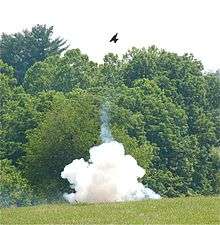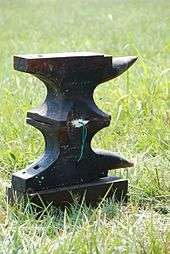Anvil firing

Anvil firing (also known in the USA as an anvil launching or an anvil shooting[1]) which in the USA is the practice of firing an anvil into the air with gunpowder. In the UK this is where black powder is filled onto the top of the Anvil and ignited. If the Anvil did not shatter it was deemed safe to use.

Typically, two anvils are used: one as a base (placed upside down), and another one (also known as the "flier") as the projectile (placed right-side up, atop the base).[2] Alternatively, a single anvil can be fired from a stone base. The space formed by the anvil's concave base is filled with black powder (not modern gunpowders, which have much higher energy densities) and a fuse is made to project out. The fuse is lit, and the resulting deflagration (the rapid combustion of the powder rather than detonation) sends the projectile anvil several feet into the air.
An alternative method is to place the bottom anvil right side up, and fill the hardy hole with black powder. A torus or washer, often made from a playing card, is placed over the hole, with a space for a fuse or powder trail. The top anvil is placed upside down, face to face with the bottom anvil.[3]
Anvil firing was once commonly performed in the Southern United States as a substitute for fireworks during celebrations. One such noteworthy celebration was held on the day the state of Texas voted to secede from the Union. On February 23, 1861, Texas Ranger and prominent Union supporter, Thomas Lopton Campbell Jr., was held captive and forced to "fire the anvils" in the streets of Austin.[4]
Anvils were also traditionally fired on St. Clement's Day, honoring Pope Clement I, the patron saint of blacksmiths and metalworkers.[5]
Although its practice has lessened in recent years, enthusiasts still participate in anvil launching events and competitions. On September 5, 2011, The Science Channel premiered Flying Anvils, a reality television series about anvil firing.[6]
Dangers
Individuals may be crushed by a falling anvil. The black powder can also prematurely ignite when the top anvil is placed, which can cause black marks on any nearby individuals.
As in any case where an explosive is confined on all sides by metal, shrapnel presents a hazard. If a damaged or structurally weak anvil is used, the anvil base may shatter upon ignition.
Physics and chemistry
The technique depends on the fact that black powder is a low explosive, which burns more rapidly when under pressure.[7]
Historical uses
A 21 anvil salute replaced the traditional 21 gun salute on Victoria Day 1860 in New Westminster, British Columbia, after the town's cannon and status as capital of British Columbia was taken away.[8]
On November 7, 1864 during the Civil War, the commander of the Iowa Home Guard militia in Davis County Iowa, having no artillery piece at his disposal, ordered a local citizen to fire an anvil in the county seat at Bloomfield to alert militiamen in outlying townships in response to intelligence received of the presence of Confederate bushwhackers in Davis County. This was in response to a report of two suspected Confederate guerrillas at a residence in the neighborhood where they had demanded money and food and had terrorized the occupants, Mr. and Mrs Gore. The private citizen who carried out the order to fire the anvil was seriously injured.[9]
Sources
- Postman, Richard (1998). Anvils in America. Berrien Springs, Michigan: Postma. ISBN 978-0-9663256-0-7. OCLC 40130801.
References
- ↑ “Anvil Shooting,” Tennessee Folk Series, Tennessee Arts Commission, The National Education Association and the Public Broadcasting System Radio Series, 1977-79.
- ↑ Cheek, Angie; Nix, Lacy Hunter, eds. (2006). "Anvil Shooting". The Foxfire 40th anniversary book : faith, family, and the land. Foxfire Fund. Anchor Books. pp. 193–196. ISBN 978-0-307-27551-6. OCLC 65538811.
- ↑ A Tennessee folklore sampler : selections from the Tennessee folklore society bulletin, 1935-2009. p. 131.
- ↑ Rockwell, Stella Campbell (1978). "ch. 9, "Boom Of Anvils"". Tumbleweed Treck. Oklahoma: Enid.
- ↑ Short, Walter (17 November 2009). "Blacksmiths celebrate St Clement's Day at Sticklepath's Finch Foundry - November 21st". okehamptonpeople. Retrieved 1 October 2010.
- ↑ "Archived copy". Archived from the original on 2013-01-28. Retrieved 2013-01-17.
- ↑ Gurstelle, William (2009). Absinthe & flamethrowers : projects and ruminations on the art of living dangerously. Chicago: Chicago Review Press. ISBN 978-1-55652-822-4. OCLC 273817829.
- ↑ "The Anvil Salute". Genes Reunited. Retrieved 1 October 2010.
- ↑ Report of Lieutenant Colonel S.A. Moore, Iowa Home Guard, January 1, 1865 in A History of Davis County Iowa, 1886, pp 556–566.
External links
| Wikimedia Commons has media related to Anvil firing. |
- "Anvil Shooting Site". Acme Anvils.